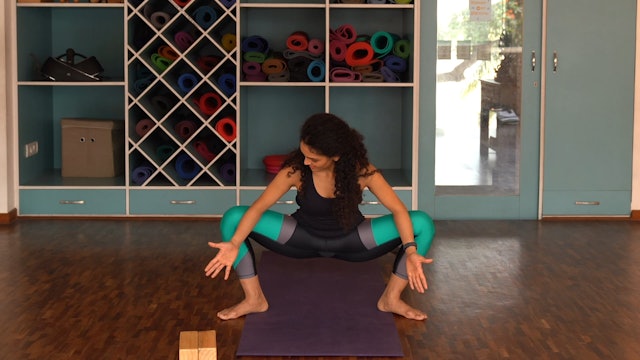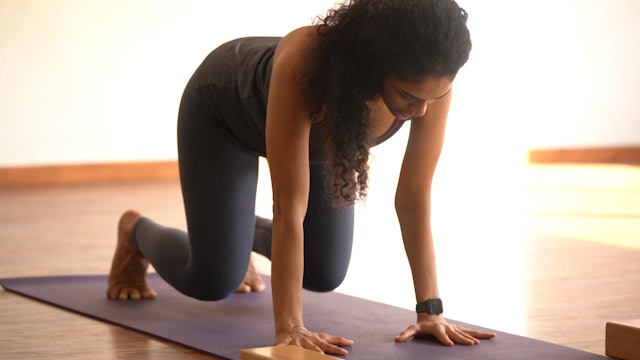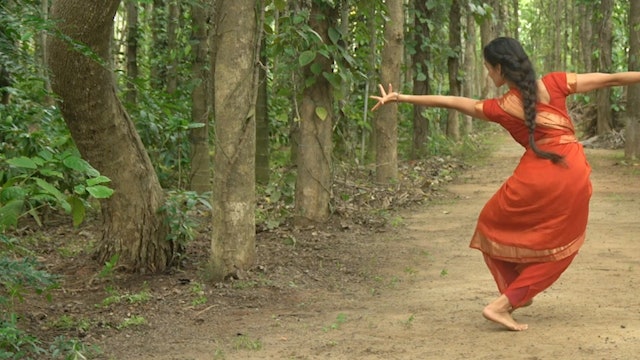-
Hip Openers
This series can be practiced after a basic warm up, before beginning an Adavu practice.
The hip opener series will help you navigate through tight hips. It will help you mobilise your hips and enable you to push your thighs back while sitting in Araimandi. Please do this in combination with str...
-
Legs and Core 2
This 25 minute workout, concentrates on your legs and core muscles. It is part of the initial series of instructed videos that have verbal cues at every step. Please pause if you need to, and take a break where necessary. It has a very small portion that has explosive movements. There is an optio...
-
Arm Strength
This short set of exercises will help develop some stability and mobility around the shoulders to enable your arm movements to become controlled and precise when dancing.
-
Jaar Adavu/ Sarikal Adavu 2
'Jaaru', literally means, to slide. This is also called the Sarikal Adavu. In the RK Method, we refer to the standing series that end in Samapada as the Jaar Adavu series and the other sliding Adavus that use Muzhumandi, and Aalidam as Sarikal adavus for simplicity.
This Adavu incorporates the ...
-
Serikal Adavu
"Serikal", means to slide. This series of Adavus include a variety of sliding movements in the Adavu series of The Raadha Kalpa Method. The first variety is introduced in this series. Technically 'Jaaru' and 'Serikal' mean the same thing, but we will call this second series of sliding Adavus as '...
-
Kartharee Adavu 1
The Kartharee adavu is a movement that begins with a jump, followed by the crossing of the legs. The name could come from the hasta that is used or from the fact that the legs cross.
The bends of the bodies vary in the various types of Kartharee adavu. We usually practice this Adavu to a three ...
-
Bramari Adavu
Bramari literally means to turn. The first Bramari adavu is introduced in the second set of Adavus, the other varieties will be introduced subsequently. It is important to keep the eyes focussed at a particular point and turn the head faster than the body.
Things to keep in mind:
- When stretc... -
Mandi 1st speed
The Mandi Adavu gets it's name from the movement that involves the knee being placed on the ground alternately.
It is very important to do the exercises that strengthen the legs substantially and do all the exercises for Araimandi for a long period of time before embarking on this Adavu.
Boun...
-
Theermana Adavu 1, variation
The Theermana or Makutadavu, is placed at the end of a Korwe or Jathi in specific rhythmic patterns, to create an ending.
The leg is either placed outstretched directly in front or at a diagonal of 45 degrees. The foot is flexed and the heel strikes the floor. In the Raadha Kalpa method we begi...
-
Theermana Adavu 2, variation
The Theermana or Makutadavu, is placed at the end of a Korwe or Jathi in specific rhythmic patterns, to create an ending.
The leg is either placed outstretched directly in front or at a diagonal of 45 degrees. The foot is flexed and the heel strikes the floor. In the Raadha Kalpa method we begi...
-
Theermana Adavu 3
The Theermana or Makutadavu, is placed at the end of a Korwe or Jathi in specific rhythmic patterns, to create an ending.
The leg is either placed outstretched directly in front or at a diagonal of 45 degrees. The foot is flexed and the heel strikes the floor. In the Raadha Kalpa method we begi...
-
Korwe Adavu (utplavana 1 )
The Korwe adavu is a combination of previously introduced foot and body articulations. It is called a Korvey adavu as it cannot be placed into any specific category. It has a Tattu, naatu, Bramari, Serikal amongst other movements. Some Korwe adavus also use a Kudittam in the feet.
Things to kee...
-
Korwe Adavu 1
The Korwe adavu is a combination of previously introduced foot and body articulations. It is called a Korvey adavu as it cannot be placed into any specific category. It has a Tattu, naatu, Bramari, Serikal amongst other movements. Some Korwe adavus also use a Kudittam in the feet.
Things to kee...
-
Tishra Eka Korwe 1
Please watch the first three lectures on Talam before beginning the Korwe series. There is an instruction video for each Korwe.
The Korwe series continues with a variety of Talams. This is the first Korwe you will learn in Tishra Eka Talam.
Try to notice the difference in the rhythmic cycle as...
-
Tishra Eka Korwe 2
Please watch the Talam lectures upto Lecture 5 before beginning this korwe. There is an instruction video for each Korwe.
The Korwe series continues with a variety of Talams. This is the second Korwe you will learn in Tishra Eka Talam.
Try to notice the difference in the rhythmic cycle as you ...
-
Adi Tala Korwe 1
Please watch the first three lectures on Talam before beginning the Korwe series. There is an instruction video for each Korwe.
A Korwe is a set of adavus that are formatted to a specific rhythmic structure, ending with a Muktayam/Teermanam adavu and layered on a Swara like in a Jatiswaram or Ta...
-
Adi Tala Korwe 2
Please watch the first three lectures on Talam before beginning the Korwe series. There is an instruction video for each Korwe.
A Korwe is a set of adavus that are formatted to a specific rhythmic structure, ending with a Muktayam/Teermanam adavu and layered on a Swara like in a Jatiswaram or Ta...
-
Adi Tala Korwe 3
Please watch the first three lectures on Talam before beginning the Korwe series. There is an instruction video for each Korwe.
A Korwe is a set of adavus that are formatted to a specific rhythmic structure, ending with a Muktayam/Teermanam adavu and layered on a Swara like in a Jatiswaram or Ta...
-
Adi Tala: Pancha Nadai/ Jathi Korwe
Please watch the Talam lectures upto Lecture 5 before beginning this Korwe. There are two parts for the instruction of this Korwe, in Adi Talam.
The Korwe series continues with a variety of Talams. This is the first Korwe in Adi Talam that layers the adavus in all 5 Jathis. (Tishra, Chatushra, K...
-
Bends: Introduction
The Raadha Kalpa Method has analysed and broken down the various torso movements into a system of bends that are different from one another. The musculature that is engaged in each bend is different and the stability necessary for execution is also different.
-
Bends 1 : Front
The Raadha Kalpa Method has analysed and broken down the various torso movements into a system of bends that are different from one another. The musculature that is engaged in each bend is different and the stability necessary for execution is also different.
This introduces the front bend.
-
Bends 2: Side
The Raadha Kalpa Method has analysed and broken down the various torso movements into a system of bends that are different from one another. The musculature that is engaged in each bend is different and the stability necessary for execution is also different.
This introduces the first type of s...
-
Bends 3 : elongated side
The Raadha Kalpa Method has analysed and broken down the various torso movements into a system of bends that are different from one another. The musculature that is engaged in each bend is different and the stability necessary for execution is also different.
This introduces the second side bend.
-
Expression Series 1: Abhinaya
This series of lectures deals with the art of expression that is inherent in Bharatanatyam. The lectures deconstruct the theatrical element of a performance while introducing and questioning ideas of expression.
The first lecture deals with the idea of Abhinaya and how we perceive it in Bharata...

























